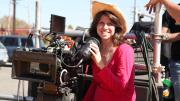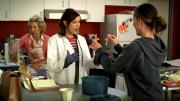Valerie Weiss, MMS ’97, Ph.D. ’01, took an unusual path after earning a doctorate in biochemistry: she immediately decamped for Los Angeles to pursue filmmaking. “For me, doing science or making movies has always been about a passion to know how things work,” writes Weiss, whose company is called PhD Productions. “My love of science stemmed from wanting to know how life works and why things are the way they are. In writing and directing movies, I approach character and story the same way — trying to get to the essence of why people are the way they are and do what they do.”
Her new movie, Losing Control, is a romantic comedy set at Harvard. After making the rounds for the past year on the festival circuit, where it won several awards (there was also a screening a year ago at Harvard’s Science Center), the film opens today in New York City, and was reviewed by The New York Times and the MIT Technology Review. Theaters in Sacramento, Tacoma, Boston, Los Angeles, and Tempe plan to open the film in coming weeks. (A trailer provides some highlights.) The movie has attracted attention from the scientifically minded; Weiss appeared on National Public Radio’s Science Friday on March 23.
Losing Control’s protagonist, Samantha “Sam” Bazarick, is a Harvard doctoral student in biochemistry who in her youth mapped out a life plan that includes reasonable goals like “speak at White House, age 16,” “Nobel prize, age 25,” and “space travel, age 26.” One of her targets, “get married, age 30,” naturally fuels the rom-com’s plot.
At the outset, anyway, that goal seems realistic. Sam’s boyfriend, Ben, could hardly be a more perfect mate: handsome, smart, thoughtful, likeable, an East Asian studies scholar who loves Sam devoutly and asks her to marry him. But she rejects his proposal on the preposterous grounds that as a scientist, she can’t commit without running a controlled experiment to see if he is really “the one.” This incident triggers Losing Control’s unlikely narrative, in which Ben heads for China and takes up with a highly attractive colleague while Sam doggedly pursues her stalled doctoral research and lurches through dating misadventures with a series of single-male-loser stereotypes. Anyone familiar with the genre knows that by the end, Ben will race halfway around the world to save the damsel in distress. There’s a time to let go of the urge to control, the movie argues, and there is indeed chemistry in the lab—and not only biochemistry.










